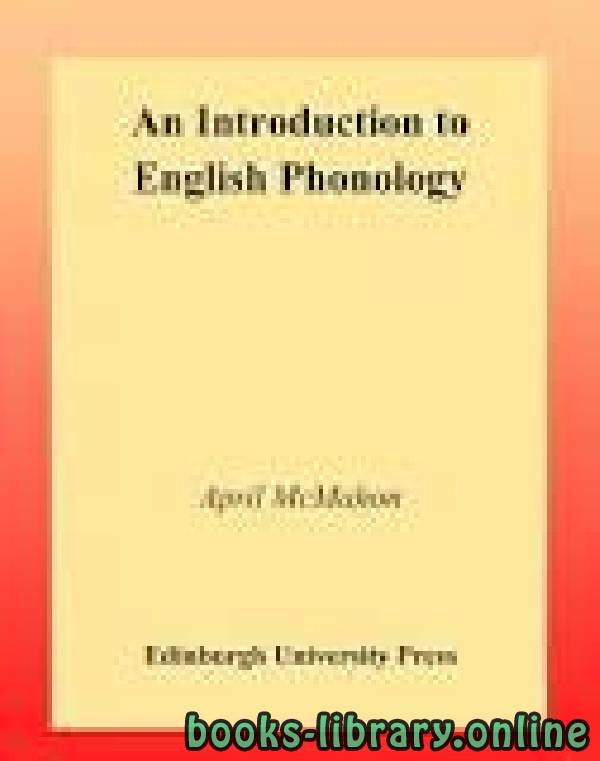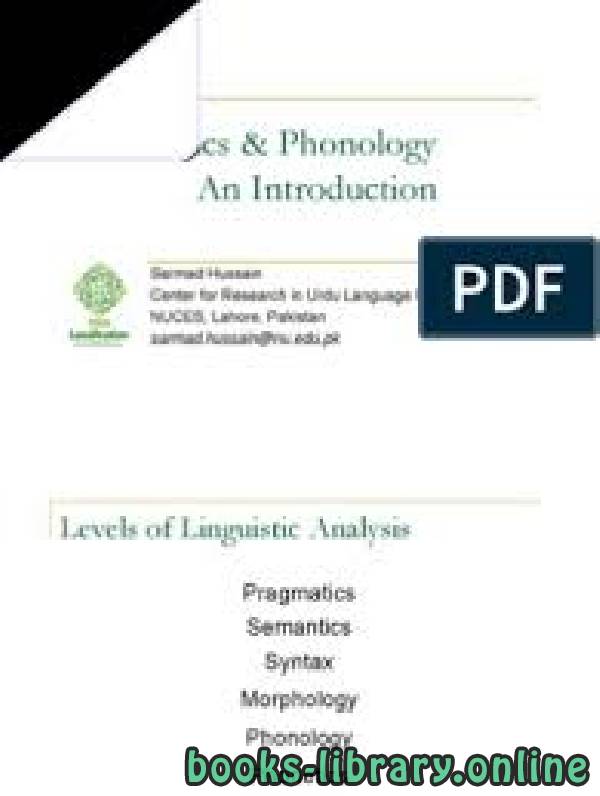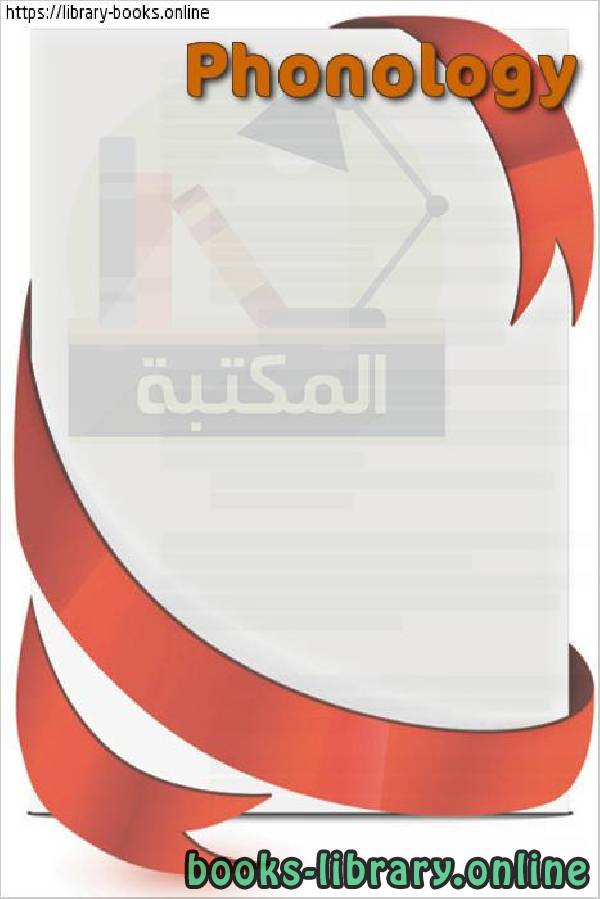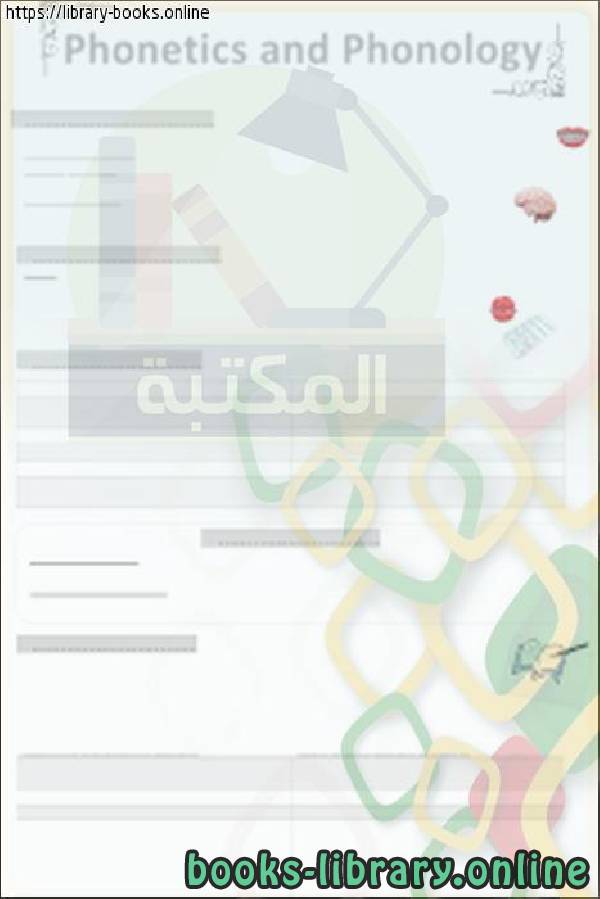كتاب Phonetics & Phonology An Introduction Sarmad Hussain
Phonetics & Phonology An Introduction Sarmad Hussain Levels of Linguistic Analysis Pragmatics Semantics Syntax Morphology Phonology Phonetics Overview - Phonetics - Phonology - Computational Phonology What is Phonetics ? - Study of human speech as a physical phenomenon - Articulation - Acoustics - Perception www.PANL10n.net 6 Articulatory Phonetics - Study of how speech sounds are produced by human vocal apparatus - Anatomy of vocal organs - Air stream Mechanism - Voicing - ArticulationSarmad Hussain - ❰ له مجموعة من الإنجازات والمؤلفات أبرزها ❞ Phonetics & Phonology An Introduction ❝ ❞ Phonetics & Phonology An Introduction Sarmad Hussain ❝ الناشرين : ❞ Center for Research in Urdu Language Processing ❝ ❱
من علم الأصوات phonology كتب تعلم اللغة الإنجليزية - مكتبة كتب تعلم اللغات.

قراءة كتاب Phonetics & Phonology An Introduction Sarmad Hussain أونلاين
معلومات عن كتاب Phonetics & Phonology An Introduction Sarmad Hussain:
An Introduction Sarmad Hussain
Levels of Linguistic Analysis
Pragmatics
Semantics
Syntax
Morphology
Phonology
Phonetics
Overview
- Phonetics
- Phonology
- Computational Phonology
What is Phonetics ?
- Study of human speech as a physical
phenomenon
- Articulation
- Acoustics
- Perception
www.PANL10n.net 6
Articulatory Phonetics
- Study of how speech sounds are produced by
human vocal apparatus
- Anatomy of vocal organs
- Air stream Mechanism
- Voicing
- Articulation
سنة النشر : 2016م / 1437هـ .
عدد مرات التحميل : 7235 مرّة / مرات.
تم اضافته في : الثلاثاء , 31 ديسمبر 2019م.
حجم الكتاب عند التحميل : 1.5MB .
تعليقات ومناقشات حول الكتاب:
هذا القسم يحتويعلي مصادر خاصة بعلم الأصوات
هو فرع من اللغويات يهتم بتنظيم الأصوات في اللغات. يركز هذا العلم تقليدياً بشكل كبير على دراسة نظم الفونيم في لغات محددة، ولكن قد تغطي أيضاً أي تحليلات لسانية سواءً على مستوى ما دون الكلمة (كالمقاطع اللفظية وغيرها) أو على جميع مستويات اللغة حيث يتم اعتبار الصوت هيكلياً لنقل المعنى اللغوي.
Phonology is a branch of linguistics concerned with the systematic
organization of sounds in spoken languages and signs in sign languages. It used to be only the study of the systems of phonemes in spoken languages (and therefore used to be also called phonemics, or phonematics), but it may also cover any linguistic analysis either at a level beneath the word (including syllable, onset and rime, articulatory gestures, articulatory features, mora, etc.) or at all levels of language where sound or signs are structured to convey linguistic meaning.[1]
Sign languages have a phonological system equivalent to the system of sounds in spoken languages. The building blocks of signs are specifications for movement, location and handshape.[2]
Contents
1 Terminology
2 Derivation and definitions
3 History
4 Analysis of phonemes
5 Other topics in phonology
6 See also
7 Notes
8 Bibliography
9 External links
Terminology
The word 'phonology' (as in the phonology of English) can also refer to the phonological system (sound system) of a given language. This is one of the fundamental systems which a language is considered to comprise, like its syntax, its morphology and its vocabulary.
Phonology is often distinguished from phonetics. While phonetics concerns the physical production, acoustic transmission and perception of the sounds of speech,[3][4] phonology describes the way sounds function within a given language or across languages to encode meaning. For many linguists, phonetics belongs to descriptive linguistics, and phonology to theoretical linguistics, although establishing the phonological system of a language is necessarily an application of theoretical principles to analysis of phonetic evidence. Note that this distinction was not always made, particularly before the development of the modern concept of the phoneme in the mid 20th century. Some subfields of modern phonology have a crossover with phonetics in descriptive disciplines such as psycholinguistics and speech perception, resulting in specific areas like articulatory phonology or laboratory phonology.
Derivation and definitions
The word phonology comes from Ancient Greek φωνή, phōnḗ, "voice, sound," and the suffix -logy (which is from Greek λόγος, lógos, "word, speech, subject of discussion"). Definitions of the term vary. Nikolai Trubetzkoy in Grundzüge der Phonologie (1939) defines phonology as "the study of sound pertaining to the system of language," as opposed to phonetics, which is "the study of sound pertaining to the act of speech" (the distinction between language and speech being basically Saussure's distinction between langue and parole).[5] More recently, Lass (1998) writes that phonology refers broadly to the subdiscipline of linguistics concerned with the sounds of language, while in more narrow terms, "phonology proper is concerned with the function, behavior and organization of sounds as linguistic items."[3] According to Clark et al. (2007), it means the systematic use of sound to encode meaning in any spoken human language, or the field of linguistics studying this use.[6]
History
Early evidence for a systematic study of the sounds in a language appears in the 4th century BCE Ashtadhyayi, a Sanskrit grammar composed by Pāṇini. In particular the Shiva Sutras, an auxiliary text to the Ashtadhyayi, introduces what may be considered a list of the phonemes of the Sanskrit language, with a notational system for them that is used throughout the main text, which deals with matters of morphology, syntax and semantics.
The study of phonology as it exists today is defined by the formative studies of the 19th-century Polish scholar Jan Baudouin de Courtenay, who (together with his students Mikołaj Kruszewski and Lev Shcherba) shaped the modern usage of the term phoneme in a series of lectures in 1876-1877. The word phoneme had been coined a few years earlier in 1873 by the French linguist A. Dufriche-Desgenettes. In a paper read at the 24th of May meeting of the Société de Linguistique de Paris,[7] Dufriche-Desgenettes proposed that phoneme serve as a one-word equivalent for the German Sprachlaut.[8] Baudouin de Courtenay's subsequent work, though often unacknowledged, is considered to be the starting point of modern phonology. He also worked on the theory of phonetic alternations (what is now called allophony and morphophonology), and may have had an influence on the work of Saussure according to E. F. K. Koerner.[9]
Nikolai Trubetzkoy, 1920s
An influential school of phonology in the interwar period was the Prague school. One of its leading members was Prince Nikolai Trubetzkoy, whose Grundzüge der Phonologie (Principles of Phonology),[5] published posthumously in 1939, is among the most important works in the field from this period. Directly influenced by Baudouin de Courtenay, Trubetzkoy is considered the founder of morphophonology, although this concept had also been recognized by de Courtenay. Trubetzkoy also developed the concept of the archiphoneme. Another important figure in the Prague school was Roman Jakobson, who was one of the most prominent linguists of the 20th century.
In 1968 Noam Chomsky and Morris Halle published The Sound Pattern of English (SPE), the basis for generative phonology. In this view, phonological representations are sequences of segments made up of distinctive features. These features were an expansion of earlier work by Roman Jakobson, Gunnar Fant, and Morris Halle. The features describe aspects of articulation and perception, are from a universally fixed set, and have the binary values + or −. There are at least two levels of representation: underlying representation and surface phonetic representation. Ordered phonological rules govern how underlying representation is transformed into the actual pronunciation (the so-called surface form). An important consequence of the influence SPE had on phonological theory was the downplaying of the syllable and the emphasis on segments. Furthermore, the generativists folded morphophonology into phonology, which both solved and created problems.
Natural phonology is a theory based on the publications of its proponent David Stampe in 1969 and (more explicitly) in 1979. In this view, phonology is based on a set of universal phonological processes that interact with one another; which ones are active and which are suppressed is language-specific. Rather than acting on segments, phonological processes act on distinctive features within prosodic groups. Prosodic groups can be as small as a part of a syllable or as large as an entire utterance. Phonological processes are unordered with respect to each other and apply simultaneously (though the output of one process may be the input to another). The second most prominent natural phonologist is Patricia Donegan (Stampe's wife); there are many natural phonologists in Europe, and a few in the U.S., such as Geoffrey Nathan. The principles of natural phonology were extended to morphology by Wolfgang U. Dressler, who founded natural morphology.
In 1976, John Goldsmith introduced autosegmental phonology. Phonological phenomena are no longer seen as operating on one linear sequence of segments, called phonemes or feature combinations, but rather as involving some parallel sequences of features which reside on multiple tiers. Autosegmental phonology later evolved into feature geometry, which became the standard theory of representation for theories of the organization of phonology as different as lexical phonology and optimality theory.
Government phonology, which originated in the early 1980s as an attempt to unify theoretical notions of syntactic and phonological structures, is based on the notion that all languages necessarily follow a small set of principles and vary according to their selection of certain binary parameters. That is, all languages' phonological structures are essentially the same, but there is restricted variation that accounts for differences in surface realizations. Principles are held to be inviolable, though parameters may sometimes come into conflict. Prominent figures in this field include Jonathan Kaye, Jean Lowenstamm, Jean-Roger Vergnaud, Monik Charette, and John Harris.
In a course at the LSA summer institute in 1991, Alan Prince and Paul Smolensky developed optimality theory—an overall architecture for phonology according to which languages choose a pronunciation of a word that best satisfies a list of constraints ordered by importance; a lower-ranked constraint can be violated when the violation is necessary in order to obey a higher-ranked constraint. The approach was soon extended to morphology by John McCarthy and Alan Prince, and has become a dominant trend in phonology. The appeal to phonetic grounding of constraints and representational elements (e.g. features) in various approaches has been criticized by proponents of 'substance-free phonology', especially by Mark Hale and Charles Reiss.[10][11]
An integrated approach to phonological theory that combines synchronic and diachronic accounts to sound patterns was initiated with Evolutionary Phonology in recent years.
Phonetics & Phonology
An Introduction
Levels of Linguistic Analysis
Pragmatics
Semantics
Syntax
Morphology
Phonology
Phonetics
Overview
- Phonetics
- Phonology
- Computational Phonology
What is Phonetics ?
- Study of human speech as a physical
phenomenon
- Articulation
- Acoustics
- Perception
www.PANL10n.net 6
Articulatory Phonetics
- Study of how speech sounds are produced by
human vocal apparatus
- Anatomy of vocal organs
- Air stream Mechanism
- Voicing
- Articulation
phonology pdf
phonological rules exercises with answers pdf
morphology pdf
phonology
phonology english
examples of phonology
phonology and phonetics
phonology pdf
branches of phonology
phonology dictionary
phonology lesson
phonetic and phonology linguistics
phonology english
phonology dictionary
english ipa
french phonology
ipa vowels english
english phonetic alphabet
examples of phonology
english phonetic r
ipa chart english
 مهلاً !
مهلاً !قبل تحميل الكتاب .. يجب ان يتوفر لديكم برنامج تشغيل وقراءة ملفات pdf
يمكن تحميلة من هنا 'تحميل البرنامج'

نوع الكتاب : pdf.
اذا اعجبك الكتاب فضلاً اضغط على أعجبني و يمكنك تحميله من هنا:


كتب اخرى في علم الأصوات phonology

An Introduction to English Phonology PDF
قراءة و تحميل كتاب An Introduction to English Phonology PDF مجانا




